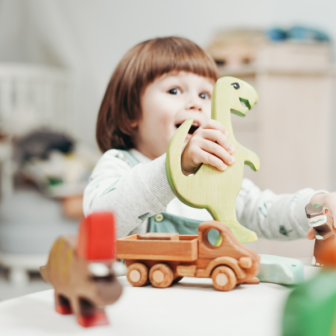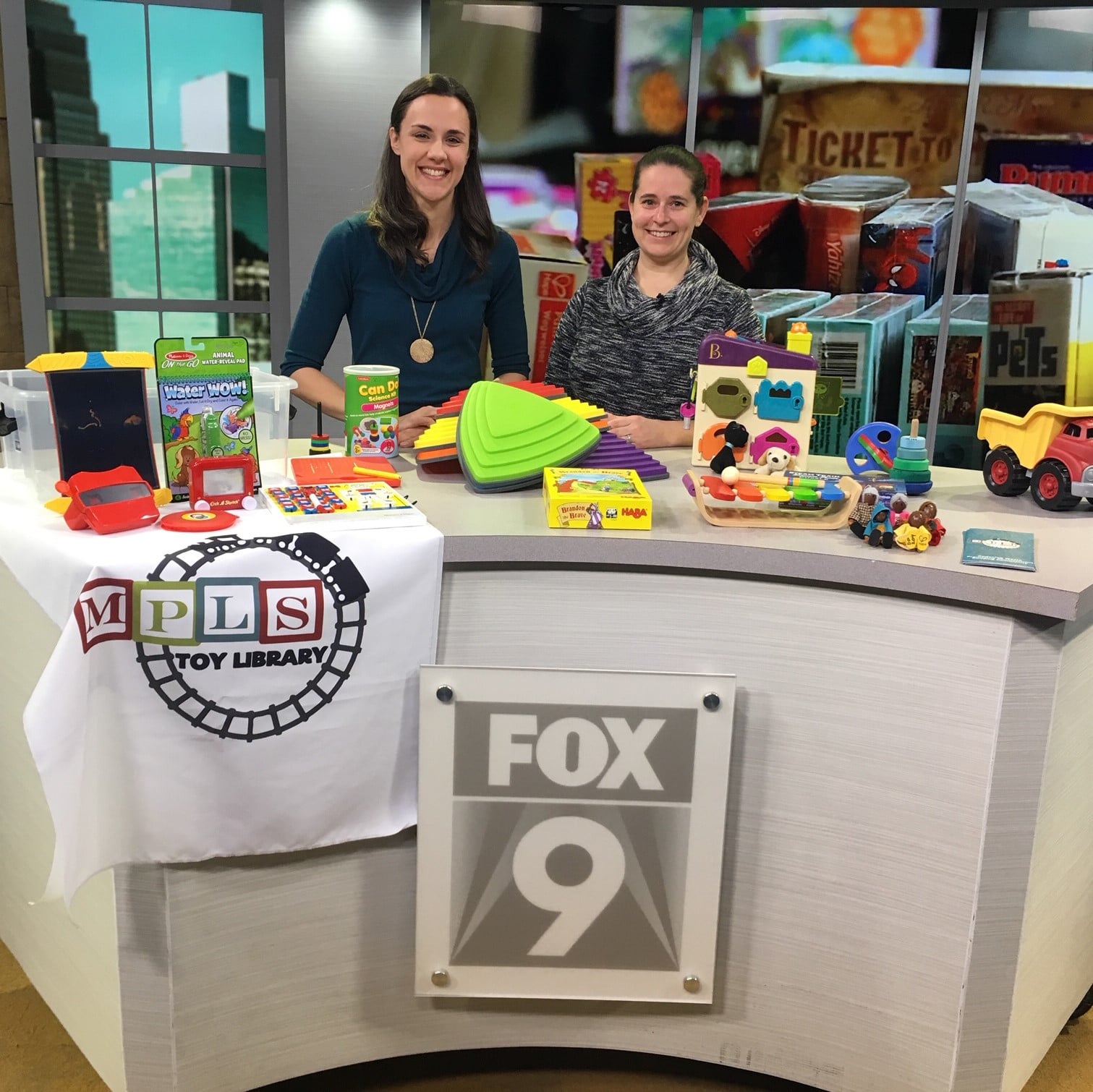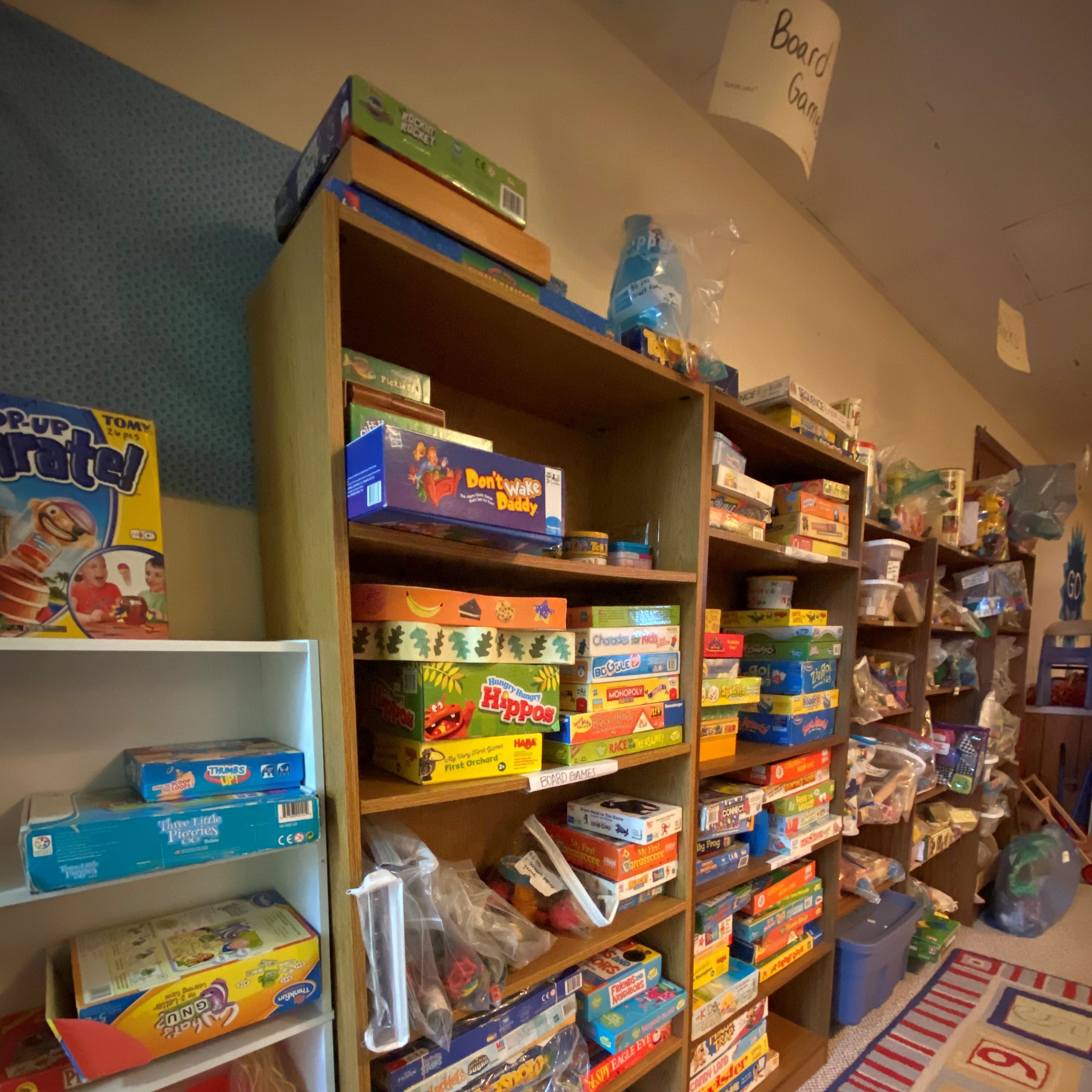
A toy lending library is a venue where parents, grandparents, and caregivers can go to borrow good-quality toys, puzzles, and games. These items can be borrowed and enjoyed at home, just like books from a “regular” library!
Toy lending libraries can offer a large selection of toys at low cost, giving families and communities access to a wide range of quality toys.
No two toy lending libraries are the same, but there are some basic approaches that can help anyone interested in creating a library for their community. Start with our guide inspired by the Minneapolis Toy Library, then check out this nationwide list of toy lending libraries for inspiration and guidance!

1) FIND YOUR FOLKS
Identify people in your community who may be excited by the idea of a toy lending library and want to help you get it going. Talk to neighbors, friends, local parenting groups, and members of your congregation, school, homeowners’ association, or local DIY space. Encourage them to get involved, either by joining in on the planning or by contributing start-up costs or toys. Don’t worry if your group is small: some libraries operate with as few as half a dozen members!
2) MEET UP AND GET DOWN (TO BUSINESS)
At your first meeting, discuss your vision for the library as well as the project’s basic parameters. What kinds of toys will you — or won’t you — offer? (We recommend no licensed characters and nothing that takes batteries!) Will your library have a designated space, or will it be mobile? Will you serve certain age groups, or kids with particular needs? How many toys will you offer at first? Will you offer just indoor toys, or outdoor toys as well? What would an ideal venue look like? Can you provide a play area? Then, identify a core team to develop the project and designate key roles. Good roles to start include a membership and outreach coordinator, a toy coordinator, a volunteer coordinator, and a financial and legal expert.
3) GET STRUCTURED
With the core team, choose what form your library will take. Will it be its own non-profit? A project of an existing organization, like a public library or neighborhood association? Or maybe you want it to be more informal, maintained mostly by motivated volunteers? If you want to be affiliated with an existing organization, reach out to them as soon as possible. Also consider staff: if you’re planning a large or independent project, it may be helpful to have one full-time staffer, like a toy coordinator.

The Minneapolis Toy Lending Library is run by Rebecca and Kari, two hardworking local moms. They are also supported by a board of directors.

To stock their library, the Minneapolis Toy Library solicited toys from parenting groups and neighborhood associations in their area. Now, they charge a sliding scale membership fee of $40 – $100, a late fee of $1, and ask members to replace or cover the cost of replacing toys damaged beyond repair.
4) SEEK SPACE
Whether you’re looking for permanent digs, or you’re planning a more pop-up style library, it’s all about location. A toy library should be a cheerful, welcoming, and accessible place, and if it’s permanent, should have space to adequately store the toy collection. Consider what already exists: community centers, churches, and public libraries may have unused space to rent for a nominal fee. If your library will be in a shared space, you’ll want lockable storage for the toys. Consider offering access to a play area, either indoors or safely enclosed outside. And to ensure that the library is safe for young children, install childproof gates and attach shelves securely to walls.
5) FIND THE FUNDS
You may not need money to start: you can build the foundation of your library by pooling a few toys from each interested family. But as the collection grows, it’s important to consider how you’ll source toys, pay for space, and compensate any staff. One option is to ask everyone involved in planning to make a contribution to a toy fund; another is to source most of your toys through a community toy drive. If you need more in the way of start-up funding, consider soliciting donations from local businesses, foundations, or even individuals. To cover ongoing costs, instate a sliding-scale membership fee for borrowing toys, and consider charging late fees or replacement fees for late or damaged items.
6) GET THOSE TOYS!
Now that you’ve got people, space, and support, it’s time to collect your inventory! Toys should be washable and well-made, and be “more kid than toy.” That means open-ended, creative toys that really need imagination to come alive: dolls, blocks, play foods, and toy instruments are great options. Avoid toys that have a media hook or that only offer one way to play. Look for toys that that will develop a wide range of skills, like hand-eye coordination and motor skills, and are versatile enough to be enjoyed by a wide age group. For kids under the age of 3, avoid long pull cords, sharp edges, brittle plastics, and small or easily detached pieces. Avoid all toys made of toxic materials, and do routine safety checks to be sure that nothing is broken or damaged. PRO TIP: keep spare toy pieces! You can get them secondhand, from manufacturers, through online auction sites, or through donations of incomplete toys.
7) KEEP TRACK OF THOSE TOYS!
To catalog and track your inventory, permanently write (or engrave, if you’re fancy) the library’s name on every toy. Include a unique ID number for easy cataloging. Categorize your toys by age group and toy type, and create a catalog for your inventory, including the toy ID number and photo, to let members browse the full range of offerings. (This is especially great for small or mobile libraries!) Assign each borrower a unique ID — it could be as simple as their name or email address — and use a spreadsheet or notebook for inventory and record keeping. When toys are returned, check that they’re clean and intact. To keep inventory up-to-date, talk to your members regularly about what they want and need, and have a suggestion box on site. Finally, create a donation policy or free box for passing on toys that no longer fit into your inventory.

The Minneapolis Toy Library is passionate about recycling toys from families with older children or other childcare centers to give toys “another chance at life”.

The Minneapolis Toy Library organizes their toy inventory by categories including board games, dramatic play, fine motor, and literacy.
8) CONSIDER STORAGE AND MAINTENANCE
Develop some storage and upkeep plans for your inventory. You might want to store or display toys in numerical sequence; by category (eg dolls, puzzles, board games); or by age group, with toys for younger kids on lower shelves. Make sure your members know to clean toys before returning them, and keep some washcloths and a spray bottle on hand at the place of returns.
9) ESTABLISH LENDING POLICIES
Make a clear list of policies for borrowers, and make it widely available. Do kids borrowing from the library need to be a certain age? How many toys can they borrow at once? How long will the lending periods last? Depending on the size of your inventory and your membership, you may decide to loan a set number of toys per family, or one expensive toy plus a number of smaller toys. (This ensures wider access to the more expensive toys, and also limits your losses should the items not be returned.) At some libraries, members are required to volunteer by helping out on-site, assisting with fundraising, or cleaning and repairing toys on their own time. Have the legal expert in your group draft a liability release form to be signed by all borrowers.
10) BUILD COMMUNITY CONNECTIONS
Building community is one of the best parts of a Toy Lending Library! Encourage members to use your own play area or to meet at a local playground. Approach community groups, small business, or individuals focused on teaching children to see if they might volunteer to lead a workshop or class at your library. Create a newsletter to keep library members informed about new toys, fundraising needs, and other items of interest, or to solicit volunteers.
About the Minneapolis Toy Lending Library
The Minneapolis Toy Library is a volunteer-led, donation-based lending library open to all families in the Minneapolis area. They are a non-profit organization run by two hardworking local moms and supported by a board of directors.
The toy library has grown from a mobile toy lending program to a thriving community organization that is now housed in a local church. With over 400 active members and nearly 4000 toys, they have helped many families save money and reduce their impact on the environment, while also providing age-appropriate toys for their growing young children.
Their biggest challenge continues to be staffing lending events with volunteers. They have reached out to local schools who have kids looking for service hours and local volunteer organizations that help match volunteers with opportunities. This has helped a bit, but they are also trying out a volunteer membership where members can pay a reduced fee when they sign up for shifts at the library.